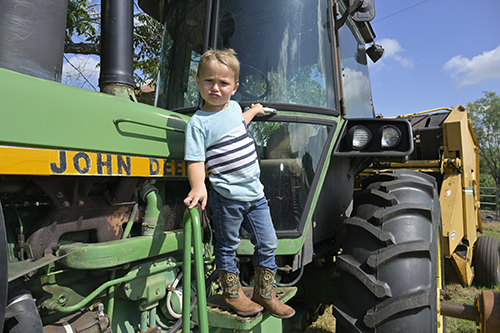At 23 weeks pregnant, Amanda went for a routine visit with her physician and discovered her baby’s stomach could not be seen on a sonogram.
“The fact that we couldn’t see Hunter’s stomach meant that he wasn’t swallowing any amniotic fluid,” Amanda said. “My doctor said he probably had esophageal atresia; his upper esophagus was separated from his lower esophagus.”
After learning that Hunter would need surgery after birth, Amanda and her husband, Adam, started searching for a pediatric surgeon and found Dr. Barry Cofer, surgeon-in-chief at CHRISTUS Children’s and associate professor of surgery at Baylor College of Medicine.
“We wanted the best for our son, so Amanda researched every doctor we came across,” said Adam. “We met with Dr. Cofer in February 2015. He explained the different types of esophageal atresia and ensured we were prepared. He even came to the hospital when Hunter was born.”
Hunter was born premature at a San Antonio hospital in March. Dr. Cofer performed diagnostic procedures shortly after Hunter was born and confirmed he was suffering from Type A, or pure esophageal atresia, the most rare and difficult type seen in infants.
“He had very minimal esophagus at all,” said Dr. Cofer. “The two ends of his esophagus were very far apart in his chest. We knew his course would be long and complicated, and it would require the resources and expertise that were best provided in a comprehensive children’s hospital. He would eventually need to be transferred to CHRISTUS Children’s for that level of expertise.”
Because Hunter could not be fed by mouth, Dr. Cofer inserted a gastrostomy tube (G-tube) in his abdomen to deliver nutrition directly to his stomach when he was two days old. They had to wait for Hunter to grow over several months and hope the two esophagus pieces would grow closer together over time. Hunter was transferred to The Children’s Hospital of San Antonio in June and underwent surgery the following day.
Dr. Cofer, with his associate Dr. John Doski and their experienced team of nurses and surgical technicians, worked on Hunter’s esophageal repair for more than four hours. It was a difficult and uncommon procedure, but the team was successful in achieving a primary repair. After surgery, Hunter was placed in a medically induced coma in the Neonatal Intensive Care Unit (NICU) for nine days, where he received expert care from neonatologist Dr. Sanjuanita Garza-Cox and her team of physicians and nurses.
“In addition to Hunter’s esophagus issue, there were other problems we had to deal with, including his prematurity and the discovery of a rare proximal fistula, or connection of his upper esophageal segment to his airway,” said Dr. Cofer. “To help with this, I recruited the assistance of Dr. Lisa Buckmiller, chief of pediatric otolaryngology (ENT) at CHRISTUS Children’s. Our team performed a series of procedures to get the connection to close correctly in a minimally invasive manner. It was very difficult, but we were successful and the fistula was closed without another major surgery.”
Hunter recovered well and was discharged from the NICU in August.
“One of the marks of a truly top tier children’s hospital is that we are able to bring together multiple specialists to care for the most complex cases,” said Dr. Cofer. “Successfully treating children with such rare and complex anomalies requires the ultimate team effort, and we are fortune to have so many talented physicians and nurses who work closely together to provide the very best care for these kids. Hunter needed pediatric subspecialists from a variety of areas – surgery, ENT, anesthesiology, pulmonology, nutrition and dietary, radiology, gastroenterology, respiratory, and speech therapy. Having specialists all under one roof is critical to the outcomes of these patients.”
“I was blown away by the exceptional care Hunter received at CHRISTUS Children’s. The high level of acuity from the physicians and nurses who helped Hunter was amazing,” said Amanda. “It’s incredible to have so many specialists all in one place and see them work together. They all know Hunter; they talk to each other; they know his case and all know their role in his care. It’s because of that team approach that Hunter is doing as well as he is. I can’t imagine getting this type of care anywhere else. They saved his life!”
Today, Hunter is a happy one-year-old and continues to see his physicians at CHRISTUS Children’s regularly. He sees occupational and speech therapists three times each week and has appointments at the Hospital once a month to dilate his esophagus.
“Hunter’s prognosis is very good. We still have to get through a few more bumps in the road, but we are confident, especially with such a wonderful medical team on our side,” added Amanda. “We have become a part of their family; Adam and I truly feel that our family is loved and genuinely cared for. I couldn’t ask for anything more.”
CHRISTUS Children’s recently welcomed Dr. Peter Nielsen as obstetrician-in-chief. He is working to launch an extensive transformation of the maternal-fetal medicine program, which will include recruiting additional physicians.
“With the addition of Dr. Nielsen, we will now able to meet the needs of expectant mothers and monitor kids like Hunter before they’re even born,” added Dr. Cofer. “They will be seen prenatally by the team, followed to term, delivered here, and cared for by the team after delivery. Our specialists will be intimately involved in the care of both mom and baby. It’s a great thing for our patients and an asset for our community.”




